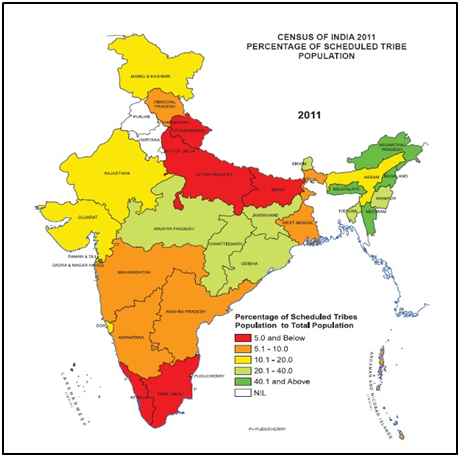Centre Looking to Design Human Development Index for Particularly Vulnerable Tribal Groups
Why in News?
- The Union government is now looking to design a survey that can gauge the Human Development Index (HDI) specifically for about 28 lakh people of the Particularly Vulnerable Tribal Groups (PVTGs).
What’s in Today’s Article?
- About Scheduled Tribes (Stats, Characteristics, About PVTGs, Govt. Schemes for PVTGs)
- News Summary
- About Eklavya Model Residential School
Scheduled Tribes in India:
- According to the 2011 Census, the Scheduled Tribes account for 104 million representing 8.6% of the country’s population.
- These Scheduled Tribes are spread throughout the country largely in forest and hilly regions.
- The essential characteristics of these communities are:
- Primitive Traits
- Geographical isolation
- Distinct culture
- Shy of contact with community at large
- Economically backwards
- Government of India set up Ministry of Tribal Affairs in 1999 after the bifurcation of Ministry of Social Justice and Empowerment.
- Objective: To provide a more focused approach towards the integrated socio-economic development of the Scheduled Tribes (the most underprivileged section of the Indian Society) in a coordinated and planned manner.
- As in the case of the Scheduled Castes, the Plan objective of empowering the tribals is being achieved through a three-pronged strategy of:
- Social empowerment,
- Economic empowerment,
- Social justice.
What is a Particularly Vulnerable Tribal Group (PVTG)?
- PVTGs are more vulnerable among the tribal groups.
- Due to this factor, more developed and assertive tribal groups take a major chunk of the tribal development funds, because of which PVTGs need more funds directed for their development.
- In this context, in 1975, the Government of India declared 52 tribal groups as PVTGs on the recommendation of Dhebar commission.
- Currently, there are 75 PVTGs out of 705 Scheduled Tribes.
- The PVTGs are spread over 18 states and one Union Territory (UT), in the country (2011 census).
- Odisha has the highest number (more than 2.5 lakh) of PVTGs.
- Characteristics of PVTGs:
- Population – stagnant/declining
- Technology – pre-agricultural
- Literacy Level – extremely low
- Economy – Subsistence level
Government Scheme(s) for PVTGs:
- Ministry of Tribal Affairs implements a scheme in the name of ‘Development of Particularly Vulnerable Tribal Groups (PVTGs)‘.
- It is a Centrally Sponsored Scheme having a provision of 100% Central assistance to 18 states and Union territory of Andaman & Nicobar Islands.
- The scheme of Development of PVTGs aims at socio-economic development of PVTGs in a comprehensive manner, while retaining their culture and heritage.
- As a part of the scheme, State Governments undertakes projects that are tailored to cater to sectors like education, health and livelihood schemes for the PVTGs.
News Summary:
- Recently, Union Minister for Tribal Affairs Shri Arjun Munda addressed media persons on 9-year achievements and Transformational initiatives of the Ministry.
- He said that development of Particularly Vulnerable Tribal Groups (PVTGs) in mission mode has been taken up as focus area for the first time ever.
- The Ministry is now looking to design a survey that can gauge the Human Development Index (HDI) specifically for about 28 lakh people of the PVTGs.
- A fund of Rs 15,000 crore has been allocated for the socio-economic development of the group for the next three years.
- The programme envisions connecting all 22,544 PVTG villages to basic government services like communications, electricity, public education, healthcare, water supply, and connectivity.
- It is part of this programme to create an HDI for PVTGs will be conducted.
- Giving details of the strides made in the education of tribal people, the minister said that the Government is setting up 740 Eklavya Residential Model Schools(EMRS) which will serve 3.5 lakh tribal students with quality education.
- Over the next three years, 38,800 teachers and support staff will be recruited centrally for the 740 EMRSs.
- These schools will also lay emphasis on local languages to ensure that the students are not detached from their roots.
- In 2023-24, a budget of Rs 12,460 Crores has been allocated to the Ministry.
About Eklavya Model Residential School (EMRS):
- EMRS started in 1997-98 with the aim of imparting quality education to children belonging to Scheduled Tribes (ST) in remote areas.
- The EMRS aims to enable students to avail of opportunities in high and professional educational courses and get employment in various sectors.
- The schools focus not only on academic education but on the all-round development of the students.
- Each school has a capacity of 480 students, catering to students from Class VI to XII.
- These are being set up by grants provided under Article 275(1) of the Constitution.
- Eklavya Model Day Boarding Schools (EMDBS) –
- Wherever density of ST population is higher in identified Sub-Districts (90% or more), it is proposed to set up Eklavya Model Day Boarding School (EMDBS) on an experimental basis.
- This is aimed at providing additional scope for ST Students seeking to avail school education without residential facility.
